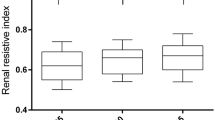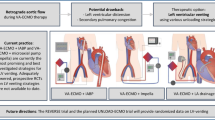Abstract
Purpose
Mannitol is used as a treatment for ischemia/reperfusion (IR) injury of various organs in humans, despite the fact that its effectiveness in vivo is still disputed. The purpose of this study was to determine the effects of mannitol on acute lung injury (ALI) induced by infrarenal aortic occlusion.
Methods
Male Wistar-albino rats were allocated into five groups: (i) sham-operated group, which received a laparotomy without IR injury (n = 12); (ii) IR group, which received 3 h of ischemia followed by 2 h of reperfusion (n = 12); (iii) IR + inferior caval phlebotomy (ICP) group, which was identical to group 2 except for 1 ml of blood aspiration from the inferior caval vein (n = 12); (iv) IR + mannitol-treated group, for which rats were subjected to IR and received a bolus injection of mannitol (n = 12); and (v) IR + ICP + mannitol-treated group, which underwent the same procedures as described for the previous groups. Arterial blood gas parameters were studied and bronchoalveolar lavage (BAL) was performed. Evans blue dye was injected into half of the rats. We biochemically assessed the degree of pulmonary tissue injury by investigating oxidative stress markers and enzymatic and nonenzymatic antioxidant markers, and evaluated ALI by establishing pulmonary leukosequestration and ALI scoring, histopathologically. Pulmonary edema was estimated by using Evans blue dye extravasation and wet/dry weight ratios.
Results
Hypertonic mannitol treatment significantly reduced oxidative stress markers, and significantly increased enzymatic and nonenzymatic antioxidant markers in the lung tissues (P < 0.05). Arterial blood gas parameters were significantly ameliorated (P < 0.05), the BAL cytology was significantly better (P < 0.05), pulmonary leukosequestration and ALI scores were significantly decreased (P < 0.05), and pulmonary edema was significantly alleviated (P < 0.05) by mannitol administration.
Conclusion
This study clearly showed that mannitol treatment significantly attenuated the aortic IR-induced ALI. Further clinical studies are required to clarify whether mannitol has a useful role in ALI during surgeries in which IR-induced organ injury occurs.
Similar content being viewed by others
References
Stallone RJ, Lim RC Jr, Blaisdell FW. Pathogenesis of the pulmonary changes following ischemia of the lower extremities. Ann Thorac Surg 1969;7:539–549.
Tassiopoulos AK, Carlin RE, Gao Y, Pedoto A, Finck CM, Landas SK, et al. Role of nitric oxide and tumor necrosis factor on lung injury caused by ischemia/reperfusion of the lower extremities. J Vasc Surg 1997;26:647–656.
Koike K, Mooer FA, Moore EE, Kim FJ, Carl VS, Banerjee A. Gut phospholipase A2 mediates neutrophil priming and lung injury after mesenteric ischemia-reperfusion. Am J Physiol 1995;268: 397–403.
Sugimoto R, Nakao A, Nagahiro I, Kohmoto J, Sugimoto S, Okazaki M, et al. Experimental orthotopic lung transplantation model in rats with cold storage. Surg Today 2009;39:641–645.
Hagiwara S, Iwasaka H, Hasegawa A, Asai N, Uchida T, Noguchi T. Dendritic cell activation in response to ischemia-reperfusion injury of the small intestine. Surg Today 2010;40:137–145.
Rudehill A, Gordon E, Ohman G, Lindqvist C, Andersson P. Pharmacokinetics and effects of mannitol on hemodynamics, blood and cerebrospinal fluid electrolytes, and osmolality during intracranial surgery. J Neurosurg Anesthesiol 1993;5:4–12.
Burke AM, Quest DO, Chien S, Cerri C. The effects of mannitol on blood viscosity. J Neurosurg 1981;55:550–553.
Cote CJ, Greenhow DE, Marshall BE. The hypotensive response to rapid intravenous administration of hypertonic solutions in man and in the rabbit. Anesthesiology 1979;50:30–35.
Goldstein S, Czapski G. Mannitol as an OH. scavenger in aqueous solutions and in biological systems. Int J Radiat Biol Relat Stud Phys Chem Med 1984;46:725–729.
Turnage RH, Kadesky KM, Bartula L, Myers SI. Intestinal reperfusion up-regulates inducible nitric oxide synthase activity within the lung. Surgery 1995;118:288–293.
Koksoy C, Kuzu MA, Kuzu I, Ergün H, Gürhan I. Role of tumour necrosis factor in lung injury caused by intestinal ischaemia-reperfusion. Br J Surg 2001;88:464–468.
Nishina K, Mikawa K, Takao Y, Maekawa N, Shiga M, Obara H. ONO-5046, an elastase inhibitor, attenuates endotoxin-induced acute lung injury in rabbits. Anesth Analg 1997;84:1097–1103.
Knight KR, Zhang B, Morrison WA, Stewart AG. Ischaemia-reperfusion injury in mouse skeletal muscle is reduced by N omega-nitro-L-arginine methyl ester and dexamethasone. Eur J Pharmacol 1997;332:273–278.
Ohkawa H, Ohishi N, Yagi K. Assay for lipid peroxides in animal tissues by thiobarbituric acid reaction. Anal Biochem 1979;95: 351–358.
Moron MS, Depierre JW, Mannervik B. Levels of glutathione, glutathione reductase and glutathione S-transferase activities in rat lung and liver. Biochem Biophys Acta 1979;82:67–78.
Winterbourn CC, Hawkins RE, Brian M, Carrell RW. The estimation of red cell superoxide dismutase activity. J Lab Clin Med 1975;85:337–341.
Pinsky MR. Antioxidant therapy for severe sepsis: promise and perspective. Crit Care Med 2003;31:2697–2698.
Buchbinder D, Karmody AM, Leather RP, Shah DM. Hypertonic mannitol. Arch Surg 1981;116:414–421.
Shah DM, Powers SR Jr, Stratton HH, Newell JC. Effects of hypertonic mannitol on oxygen utilization in canine hind limbs following shock. J Surg Res 1981;30:593–601.
Faust KB, Chiantella V, Vinten-Johansen J, Meredith JH. Oxygenderived free radical scavengers and skeletal muscle ischemic/reperfusion injury. Am Surg 1988;54:709–719.
Shah DM, Bock DE, Darling RC 3rd, Chang BB, Kupinski AM, Leather RP. Beneficial effects of hypertonic mannitol in acute ischemia-reperfusion injuries in humans. Cardiovasc Surg 1996;4: 97–100.
England MD, Cavarocchi NC, O’Brien JF, Solis E, Pluth JR, Orszulak TA, et al. Influence of antioxidants (mannitol and allopurinol) on oxygen free radical generation during and after cardiopulmonary bypass. Circulation 1986;74:134–137.
Haraldsson G, Sörensen V, Nilsson U, Pettersson S, Rashid M, Scherstén T, et al. Effect of pre-treatment with desferrioxamine and mannitol on radical production and kidney function after ischaemia-reperfusion. A study on rabbit kidney. Acta Physiol Scand 1995;154:461–468.
Weinbroum AA, Hochhauser E, Rudick V, Kluger Y, Karchevsky E, Graf E, et al. Multiple organ dysfunction following remote circulatory arrest: common pathway of radical oxygen species? J Trauma 1999;47:691–698.
Weinbroum AA, Kluger Y, Rudick V. Impairment of aortal tone by no flow-reflow conditions and its partial amelioration by mannitol. Ann Thorac Surg 2000;69:1439–1444.
Weinbroum AA, Shapira I, Ben-Abraham R, Szold A. Mannitol dose-dependently attenuates lung reperfusion injury following liver ischemia reperfusion: a dose-response study in an isolated-perfused double-organ model. Lung 2003;180:327–338.
Kretzschmar M, Klein U, Palutke M, Schirmeister W. Reduction of ischemia-reperfusion syndrome after abdominal aortic aneurysmectomy by N-acetylcysteine but not mannitol. Acta Anaesthesiol Scand1996;40:657–664.
Hernandez LA, Grisham MB, Twohig B, Arfors KE, Harlan JM, Granger DN. Role of neutrophils in ischemia-reperfusion-induced microvascular injury. Am J Physiol 1987;253:699–703.
Welbourn CRB, Paterson IS, Klausner JM, Goldman G, Kobzik L, Valeri CR, et al. Mannitol modifies lower torso ischemia induced lung injury by a non-osmotic mechanism. FASEB J 1989;3;A290.
Justicz AG, Farnsworth WV, Soberman MS, Tuvlin MB, Bonner GD, Hunter RL, et al. Reduction of myocardial infarct size by poloxamer 188 and mannitol in a canine model. Am Heart J 1991;122:671–680.
Schlag MG, Clarke S, Carson MW, Harris KA, Potter RF. The effect of mannitol versus dimethyl thiourea at attenuating ischemia/reperfusion-induced injury to skeletal muscle. J Vasc Surg 1999;29:511–521.
Schmeling DJ, Caty MG, Oldham KT, Guice KS, Hinshaw DB. Evidence for neutrophil-related acute lung injury after intestinal ischemia-reperfusion. Surgery 1989;106:195–201.
Klausner JM, Paterson IS, Goldman G, Kobzik L, Valeri CR, Shepro D, et al. Thromboxane A2 mediates increased pulmonary microvascular permeability following limb ischemia. Circ Res 1989;64:1178–1189.
Tomashefski JF. Pulmonary pathology of acute respiratory distress syndrome. Clin Chest Med 2000;21:435–466.
Kalia N, Brown NJ, Hopkinson K, Stephenson TJ, Wood RF, Pockley AG. FK409 inhibits both local and remote organ damage after intestinal ischemia. J Pathol 2002;197:595–602.
Shen L, Zhang J. Ginsenoside Rg1 increases ischemia-induced cell proliferation and survival in the dentate gyrus of adult gerbils. Neurosci Lett 2003;344:1–4.
Fu W, Jiao X. The effect of mannitol and anisodamin on the prevention of free radical injury to post-ischaemia flaps: an experimental study. Br J Plast Surg 1995;48:218–221.
Author information
Authors and Affiliations
Rights and permissions
About this article
Cite this article
Teke, Z., Adali, F., Kelten, E.C. et al. Mannitol attenuates acute lung injury induced by infrarenal aortic occlusion-reperfusion in rats. Surg Today 41, 955–965 (2011). https://doi.org/10.1007/s00595-010-4394-x
Received:
Accepted:
Published:
Issue Date:
DOI: https://doi.org/10.1007/s00595-010-4394-x




